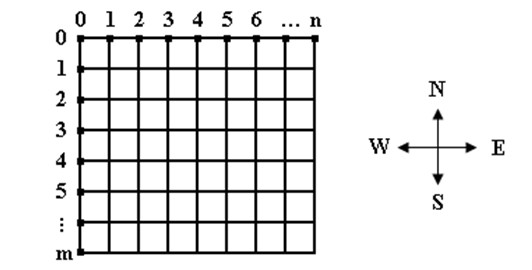EscapeTime Limit: 20000/10000 MS (Java/Others) Memory Limit: 32768/32768 K (Java/Others)
Problem Description
The students of the HEU are maneuvering for their military training.
The red army and the blue army are at war today. The blue army finds that Little A is the spy of the red army, so Little A has to escape from the headquarters of the blue army to that of the red army. The battle field is a rectangle of size m*n, and the headquarters of the blue army and the red army are placed at (0, 0) and (m, n), respectively, which means that Little A will go from (0, 0) to (m, n). The picture below denotes the shape of the battle field and the notation of directions that we will use later.  The blue army is eager to revenge, so it tries its best to kill Little A during his escape. The blue army places many castles, which will shoot to a fixed direction periodically. It costs Little A one unit of energy per second, whether he moves or not. If he
Input
For every test case, the first line has four integers, m, n, k and d (2<=m, n<=100, 0<=k<=100, m+ n<=d<=1000). m and n are the size of the battle ground, k is the number of castles and d is the units of energy Little A initially has. The next k lines describe
the castles each. Each line contains a character c and four integers, t, v, x and y. Here c is ‘N’, ‘S’, ‘E’ or ‘W’ giving the direction to which the castle shoots, t is the period, v is the velocity of the bullets shot (i.e. units passed per second), and (x, y) is the location of the castle. Here we suppose that if a castle is shot by other castles, it will block others’ shots but will NOT be destroyed. And two bullets will pass each other without affecting their directions and velocities. All castles begin to shoot when Little A starts to escape. Proceed to the end of file.
Output
If Little A can escape, print the minimum time required in seconds on a single line. Otherwise print “Bad luck!” without quotes.
Sample Input
Sample Output
Source
#include<stdio.h>
#include<iostream>
#include<queue>
#include<string.h>
using namespace std;
struct man{
short x,y,t;
};
int n,m,k,energy;
int dir[4][2]={{-1,0},{1,0},{0,-1},{0,1}};
bool tmap[101][101][1001];//前两维代表坐标,后一维表时时间:意为每个位置的每个时刻有没子弹和碉堡(这里一定要用bool,用int会超内存)
bool vist[101][101][1001];//第几个时刻的位置走过否
int OK(int x,int y,int time)//返回1说明位位置的当前时间可以走,加入队列
{
if(x>=0&&x<=n&&y>=0&&y<=m&&!tmap[x][y][time]&&n-x+m-y<=energy-time&&!vist[x][y][time])
{
vist[x][y][time]=true; return 1;
}
return 0;
}
void bfs()
{
queue<man>qMan;
man pMan,tpMan;
int time=0,x,y;
pMan.x=0; pMan.y=0; pMan.t=0;
if(OK(pMan.x,pMan.y,time))
qMan.push(pMan);
while(true)
{
time++;
if(qMan.empty()||time>energy)
{
printf("Bad luck!\n"); return ;
}
while(!qMan.empty())
{
pMan=qMan.front();
if(pMan.t>=time)
break;
qMan.pop();
pMan.t=time;
if(OK(pMan.x,pMan.y,time))//可以停在原地
qMan.push(pMan);
for(int e=0;e<4;e++)
{
tpMan=pMan;
tpMan.x+=dir[e][0]; tpMan.y+=dir[e][1];
if(OK(tpMan.x,tpMan.y,time))
{
if(tpMan.x==n&&tpMan.y==m)
{
printf("%d\n",time); return ;
}
qMan.push(tpMan);
}
}
}
}
}
int main()
{
char ss[3];
int map[105][105];
int tx,ty,x[105],y[105],T[105],v[105],d[105];
while(scanf("%d%d%d%d",&n,&m,&k,&energy)>0)
{
for(int i=0;i<=n;i++)
for(int j=0;j<=m;j++)
for(int t=0;t<=energy;t++)
tmap[i][j][t]=vist[i][j][t]=false;
memset(map,0,sizeof(map));
for(int i=0;i<k; i++)
{
scanf("%s%d%d%d%d",ss,&T[i],&v[i],&x[i],&y[i]);
if(ss[0]=='N') d[i]=0;
else if(ss[0]=='S') d[i]=1;
else if(ss[0]=='W') d[i]=2;
else if(ss[0]=='E') d[i]=3;
map[x[i]][y[i]]=1;//碉堡位置
}
//计算每个时刻子弹和碉堡在地图的位置
for(int i=0;i<k; i++)
{
for(int t=1;t<=energy; t++)//一开始当前碉堡发出的子弹的每个时间运行
{
tmap[x[i]][y[i]][t]=true;//每个刻碉堡的位置
//第i个碉堡一开始发的子弹运行了t时到达的位置
tx=x[i]+dir[d[i]][0]*v[i]*t;
ty=y[i]+dir[d[i]][1]*v[i]*t;
if(tx>=0&&tx<=n&&ty>=0&&ty<=m)//是否越界
for(int tt=t; tt<=energy; tt+=T[i])//第i个碉堡发出的子弹周期性的到达同一位置
if(!tmap[tx][ty][tt])
{
//判断从第i个碉堡位置发出的子弹能否到达位置(tx,ty)
int flag=0,xx=x[i],yy=y[i];
if(d[i]==0)
{
for( xx=x[i]-1; xx>=tx; xx--)
if(map[xx][yy])
break;
if(xx<tx) flag=1;
}
else if(d[i]==1)
{
for( xx=x[i]+1; xx<=tx; xx++)
if(map[xx][yy])
break;
if(xx>tx) flag=1;
}
else if(d[i]==2)
{
for(yy=y[i]-1; yy>=ty; yy--)
if(map[xx][yy])
break;
if(yy<ty) flag=1;
}
else
{
for(yy=y[i]+1; yy<=ty; yy++)
if(map[xx][yy])
break;
if(yy>ty) flag=1;
}
if(flag)//能到达,说明路过的地没有其他碉堡阻挡
tmap[tx][ty][tt]=true;
}
}
}
bfs();
}
}
|
EscapeTime Limit: 20000/10000 MS (Java/Others) Memory Limit: 32768/32768 K (Java/Others)
Problem Description
The students of the HEU are maneuvering for their military training.
The red army and the blue army are at war today. The blue army finds that Little A is the spy of the red army, so Little A has to escape from the headquarters of the blue army to that of the red army. The battle field is a rectangle of size m*n, and the headquarters of the blue army and the red army are placed at (0, 0) and (m, n), respectively, which means that Little A will go from (0, 0) to (m, n). The picture below denotes the shape of the battle field and the notation of directions that we will use later.  The blue army is eager to revenge, so it tries its best to kill Little A during his escape. The blue army places many castles, which will shoot to a fixed direction periodically. It costs Little A one unit of energy per second, whether he moves or not. If he
Input
For every test case, the first line has four integers, m, n, k and d (2<=m, n<=100, 0<=k<=100, m+ n<=d<=1000). m and n are the size of the battle ground, k is the number of castles and d is the units of energy Little A initially has. The next k lines describe
the castles each. Each line contains a character c and four integers, t, v, x and y. Here c is ‘N’, ‘S’, ‘E’ or ‘W’ giving the direction to which the castle shoots, t is the period, v is the velocity of the bullets shot (i.e. units passed per second), and (x, y) is the location of the castle. Here we suppose that if a castle is shot by other castles, it will block others’ shots but will NOT be destroyed. And two bullets will pass each other without affecting their directions and velocities. All castles begin to shoot when Little A starts to escape. Proceed to the end of file.
Output
If Little A can escape, print the minimum time required in seconds on a single line. Otherwise print “Bad luck!” without quotes.
Sample Input
Sample Output
Source
|